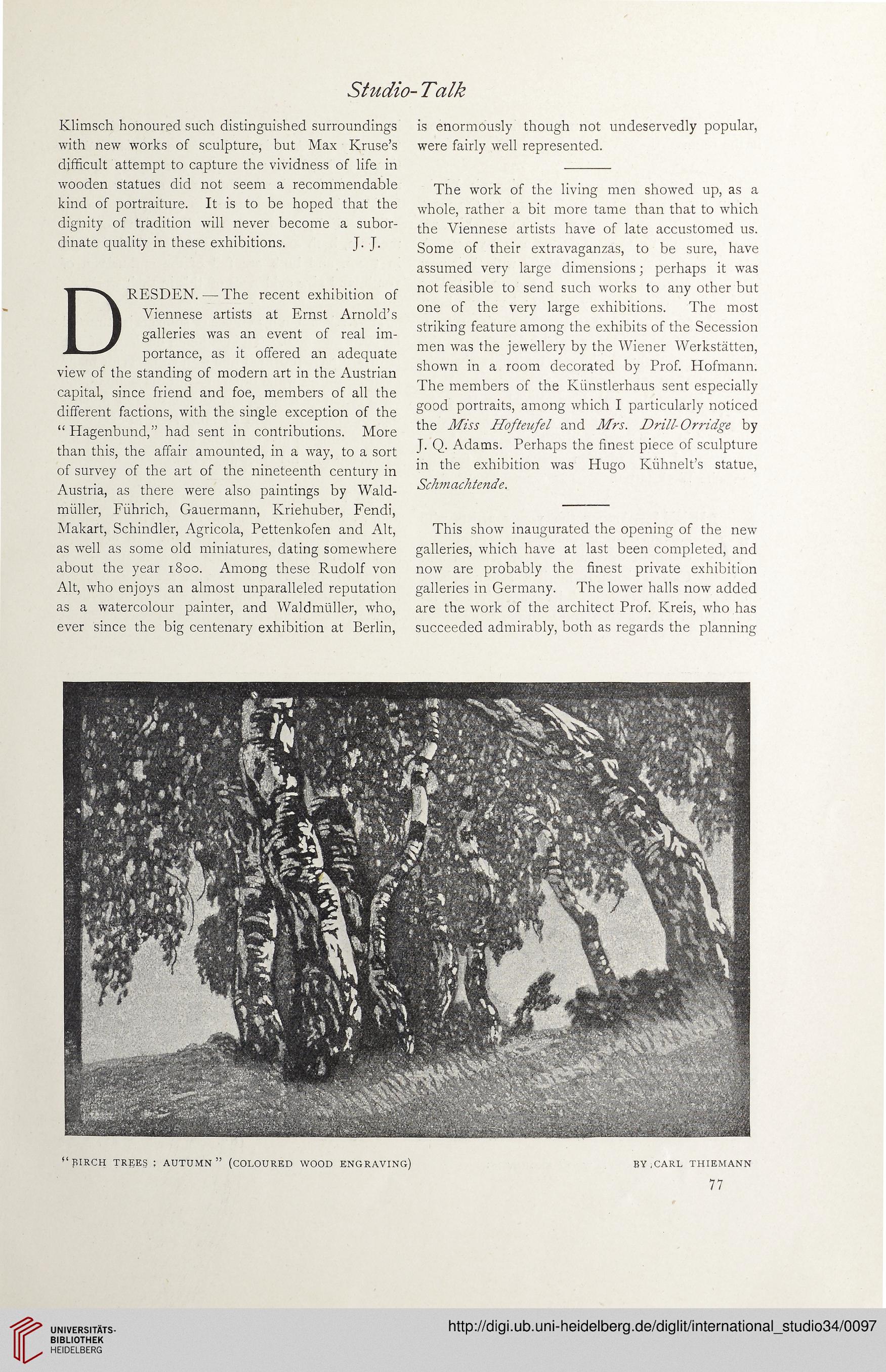Studio- Talk
Klimsch honoured such distinguished surroundings
with new works of sculpture, but Max Kruse’s
difficult attempt to capture the vividness of life in
wooden statues did not seem a recommendable
kind of portraiture. It is to be hoped that the
dignity of tradition will never become a subor-
dinate quality in these exhibitions. J. J.
DRESDEN.—The recent exhibition of
Viennese artists at Ernst Arnold’s
galleries was an event of real im-
portance, as it offered an adequate
view of the standing of modern art in the Austrian
capital, since friend and foe, members of all the
different factions, with the single exception of the
“ Hagenbund,” had sent in contributions. More
than this, the affair amounted, in a way, to a sort
of survey of the art of the nineteenth century in
Austria, as there were also paintings by Wald-
miiller, Fiihrich, Gauermann, Kriehuber, Fendi,
Makart, Schindler, Agricola, Pettenkofen and Alt,
as well as some old miniatures, dating somewhere
about the year 1800. Among these Rudolf von
Alt, who enjoys an almost unparalleled reputation
as a watercolour painter, and Waldmiiller, who,
ever since the big centenary exhibition at Berlin,
is enormously though not undeservedly popular,
were fairly well represented.
The work of the living men showed up, as a
whole, rather a bit more tame than that to which
the Viennese artists have of late accustomed us.
Some of their extravaganzas, to be sure, have
assumed very large dimensions; perhaps it was
not feasible to send such works to any other but
one of the very large exhibitions. The most
striking feature among the exhibits of the Secession
men was the jewellery by the Wiener Werkstatten,
shown in a room decorated by Prof. Hofmann.
The members of the Kiinstlerhaus sent especially
good portraits, among which I particularly noticed
the Miss Hofteufel and Mrs. Drill-Orridge by
J. Q. Adams. Perhaps the finest piece of sculpture
in the exhibition was Hugo Kuhnelt’s statue,
Schmachtende.
This show inaugurated the opening of the new
galleries, which have at last been completed, and
now are probably the finest private exhibition
galleries in Germany. The lower halls now added
are the work of the architect Prof. Kreis, who has
succeeded admirably, both as regards the planning
fi pIRCH TREES ; AUTUMN” (COLOURED WOOD ENGRAVING)
BY,CARL THIEMANN
77
Klimsch honoured such distinguished surroundings
with new works of sculpture, but Max Kruse’s
difficult attempt to capture the vividness of life in
wooden statues did not seem a recommendable
kind of portraiture. It is to be hoped that the
dignity of tradition will never become a subor-
dinate quality in these exhibitions. J. J.
DRESDEN.—The recent exhibition of
Viennese artists at Ernst Arnold’s
galleries was an event of real im-
portance, as it offered an adequate
view of the standing of modern art in the Austrian
capital, since friend and foe, members of all the
different factions, with the single exception of the
“ Hagenbund,” had sent in contributions. More
than this, the affair amounted, in a way, to a sort
of survey of the art of the nineteenth century in
Austria, as there were also paintings by Wald-
miiller, Fiihrich, Gauermann, Kriehuber, Fendi,
Makart, Schindler, Agricola, Pettenkofen and Alt,
as well as some old miniatures, dating somewhere
about the year 1800. Among these Rudolf von
Alt, who enjoys an almost unparalleled reputation
as a watercolour painter, and Waldmiiller, who,
ever since the big centenary exhibition at Berlin,
is enormously though not undeservedly popular,
were fairly well represented.
The work of the living men showed up, as a
whole, rather a bit more tame than that to which
the Viennese artists have of late accustomed us.
Some of their extravaganzas, to be sure, have
assumed very large dimensions; perhaps it was
not feasible to send such works to any other but
one of the very large exhibitions. The most
striking feature among the exhibits of the Secession
men was the jewellery by the Wiener Werkstatten,
shown in a room decorated by Prof. Hofmann.
The members of the Kiinstlerhaus sent especially
good portraits, among which I particularly noticed
the Miss Hofteufel and Mrs. Drill-Orridge by
J. Q. Adams. Perhaps the finest piece of sculpture
in the exhibition was Hugo Kuhnelt’s statue,
Schmachtende.
This show inaugurated the opening of the new
galleries, which have at last been completed, and
now are probably the finest private exhibition
galleries in Germany. The lower halls now added
are the work of the architect Prof. Kreis, who has
succeeded admirably, both as regards the planning
fi pIRCH TREES ; AUTUMN” (COLOURED WOOD ENGRAVING)
BY,CARL THIEMANN
77




